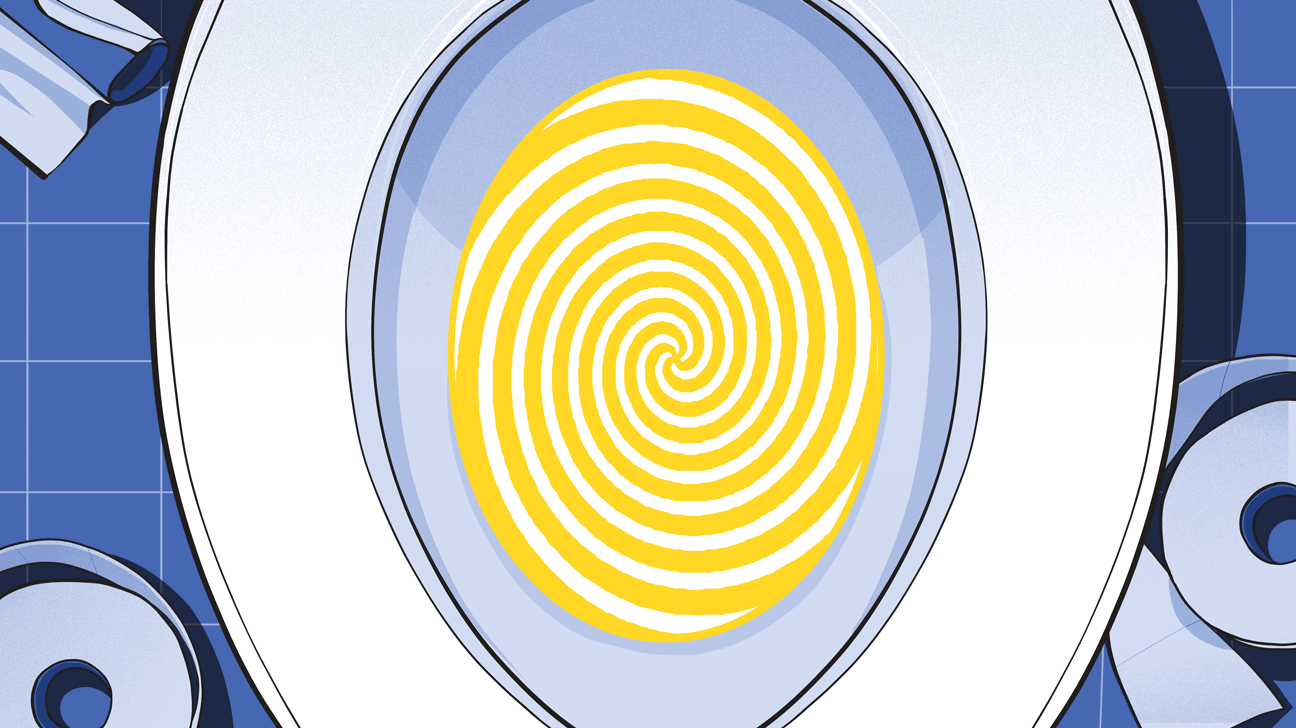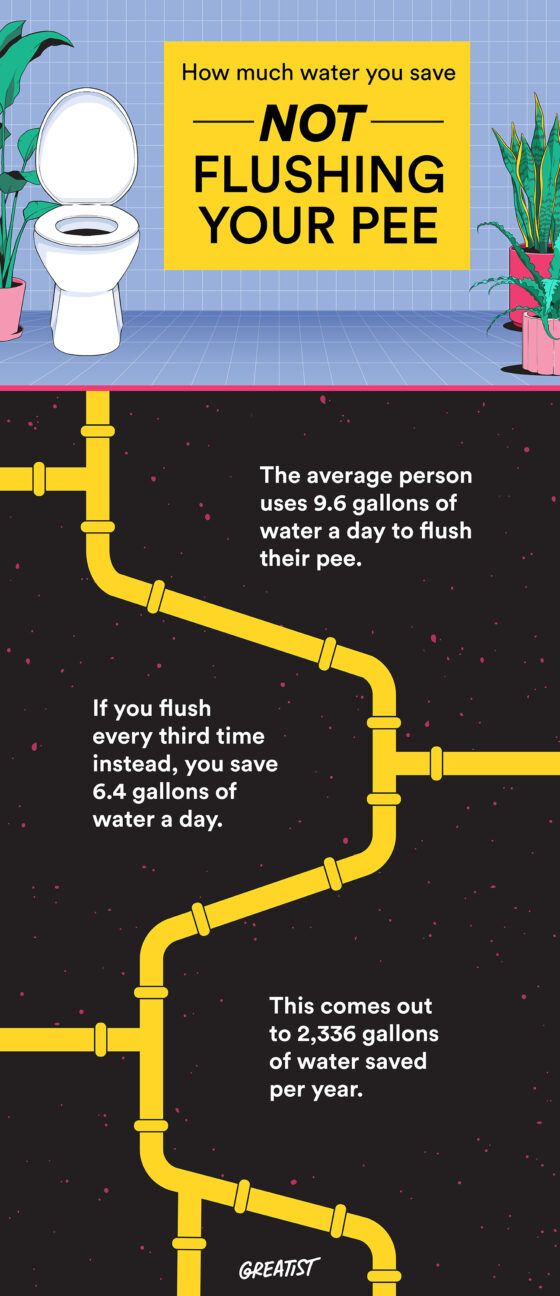
There are two camps of people in this world: the “If it’s yellow, let it mellow” camp and the “Every time you piddle, the lever you must diddle” camp. (Yeah, we totally just made up that phrase.)
The former says flushing pee needlessly wastes the most precious planetary resource, while the latter says the water saved is negligible — and not worth the “ew” factor.
Perhaps you’re locked in a “to flush or not to flush?” face-off with a partner or roommate. Or maybe you’re just trying to decide if this is the best way to actually conserve water. Well, we’re here to settle this whiz war once and for all by actually digging into the facts — and the math.
It’s totally safe to let your pee sit in the bowl, BTW
Some people say that flushing comes down to hygiene. So we asked an epidemiologist to give us the scoop.
“Just because you are grossed out by it doesn’t mean that it is a health hazard,” says Brian Labus, PhD, MPH, assistant professor of public health at the University of Las Vegas School of Public Health. “Unless you have a urinary tract infection, your urine is sterile. Even if it isn’t, municipal water contains residual chlorine that can kill pathogens introduced into it.”
OK, so you’re not gonna get sick from stagnant pee just chilling in the bowl. Phew! Now let’s talk about the environmental factor. It’s true that when you flush, water literally goes down the toilet. But how much are you actually using by washing away your bodily waste?
If you’ve ever wondered how many times you typically tinkle in a day, you could track that, of course. But experts say the average adult pees 6 or 7 times in a 24-hour period.
Since 1994, EPA regulations have required all toilets in the United States to use no more than 1.6 gallons of water per flush.
Please hold while we pull up the calculator app…

OK, if you press that lever for every whiz, you flush 9.6 gallons of water each day. This amounts to about 3,504 gallons per year.
Now, let’s say you flush every third time instead. This saves you 6.4 gallons a day, or 2,336 gallons per year.
Flushing is an example of direct water usage (water we come into contact with or see when we use it). And because we actually see this water swirling down the drain, it feels significant.
But we never actually see most of the water we use in our lives (such as the water it takes to produce the food we eat or the products we buy). Taking this indirect water usage into account can help put flushing into perspective.
For example, raising and processing the beef to make the average hamburger (1/3 pound) requires 660 gallons of water. That’s 412 flushes gone over the course of a lunch.
Let’s do another, for funsies. It takes 3,045 gallons of water to produce a half gallon of almond milk. That’s 1,903 flushes!
In fact, agricultural production accounts for 92 percent of global water consumption. So if you’re aiming to save big on H2O, making tweaks to your diet has more of an impact than letting the yellow mellow.
Foods with the largest water footprints
Unfortunately, some of the worst offenders are also some of our favorite foods. But don’t feel like you have to cut these foods out altogether — moderation is the ticket.
- Beef. It takes 660 gallons of water to produce a hamburger.
- Pork. It takes about 135 gallons of water to produce a 3-ounce serving of pork.
- Coffee. It takes about 66 gallons of water to produce an 8-ounce cup of coffee.
- Almond milk. It takes 3,045 gallons of water to produce a half gallon of almond milk.
The penny pinchers out there argue that water isn’t free, so every flush you save is money in the bank. And while that’s technically true, it’s really only a blip on your budget.
According to the U.S. Department of Energy, the average cost per flush in the United States is just over a penny: ~1.3 cents. (Keep in mind that water prices vary a lot from city to city, so this is just a rough average.)
By the same math we did above, flushing every third time you tinkle (twice a day) instead of every time (6 times a day), saves you $18.98 a year, about the same as 2 months of your Netflix subscription.
And even if your water bill is twice the average, you’re still only saving about $38 per year.
If you’re in the “let it mellow” camp, you might be thinking, OK, but what’s the harm in letting it sit? Allow us…
It gunks up your toilet bowl faster
Urine and hard water deposits leave hardened mineral deposits around your toilet bowl over time. These deposits form faster when you let pee sit around.
In some cases, rings left for too long can be nearly impossible to remove without harsh cleansers that can be worse for the environment than those extra flushes. Plus, those cleaning supplies could cost you more money in the long run than you’re saving on your water bill.
It makes the whole bathroom smell like pee
Your potty scent isn’t exactly like fresh-baked cookies. And dehydration, diet, and some medical conditions can make it quite potent. (That asparagus you had for lunch will hit some people as a sulfurous smell emanating from the bowl.)
Even if you don’t mind the smell of pee, keep in mind that people have varying sensitivity to scents and process them differently. Some love the scent of honeysuckle, for example, but it makes others want to vom.
Do you really want to make your roommate wince every time they open the bathroom door?
There’s no denying that water is the most precious natural resource. We get the urge to conserve.
But if you live with folks who abhor your no-flushing ways, the water and money you save probably aren’t worth the tension and unease it creates in your household.
Plus, if someone is grossed out by your non-flush, they’ll probably just press the lever anyway before they do their own business, negating your efforts. (If you aren’t sure how the other people in your house feel, just ask!)
And if not flushing is a habit you’re simply not willing to flush (yeah, yeah, sorry for the pun), it might be time to start saving up to live solo or get your own bathroom. That way you can do all the yellow-mellowing your heart desires.

